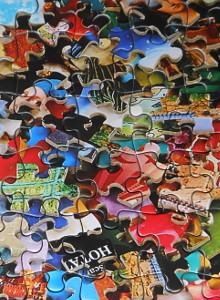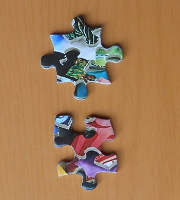Chit-chat from Imaginatorium Shop
Blog posts in 2019
March — Ultimate challenge?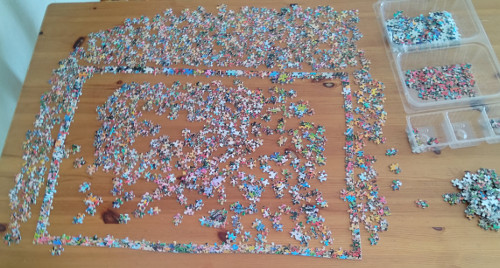
There is an interesting range from Beverly of "Puzzler's puzzles," just chosen to be different or difficult. The latest they have called "Jigsomania" (the way "Jigsaw" is written in Japanese looks like ji-gu-so-o, hence the 'o'), consisting simply of a photograph of a pile of jigsaw puzzle pieces. I did the 1000-piece version; there is also a 300-piece.
SpoilerWell, not really quite a spoiler, because there is no simple solution! But here are some hints on cracking this one...
Technically the photograph in this puzzle is a bit of a disaster. You would have thought the art department would be given the job of making a nice pile of pieces, then reproducing it "flat" – with the axis of the lens perpendicular to the subject, and appropriate lens and aperture to make it crisply in focus everywhere. (Just as if you put the pieces upside down on a photocopier.) But this looks rather as if someone said "No need for anything technical; my phone's got eight squillion pixels..." The result is that very little of the image is even in focus, and it was taken at an angle, with a wide-angle lens, so the bottom corners in particular are totally blurred.
The counter argument would have to be that someone could see how hard the puzzle would be, and thought they would offer some clues. There are actually two ways in which it is easier: identifying the degree of blur tells you a lot about where the piece might go, and the viewing angle means that for almost any piece, you can immediately see which way up it goes. The latter is extremely unusual: for most "hard bits", the sky for example, you can at least look at the paper grain on the back of the piece to see if it is vertical or horizontal, but when trying a piece you automatically check whether it might go in upside down. I found myself having to consciously avoid wasting time doing this!
So here's my suggested best strategy:
You will need lots of space to keep the groups of connected pieces, and it hardly needs saying that you will need enormous reserves of patience. Good luck! ... photo of completed puzzle follows shortly - once I have it framed! September — Changing namesSome things never change,... but others do. Imaginatorium Shop has now been operating for seventeen years, and very little has changed in the puzzle brands that we sell. Just one, the "Road" brand, disappeared in 2017, and the Apollo company was aborbed by Epoch. The Apollo brand is being phased out for full-size puzzles but is still used for children's puzzles and other toys. But one of the brands has a long-term split personality. This is the Artbox range of puzzles, produced from 1986 by the Amada printing company. While retaining the Artbox name, it adopted a separate name, "Ensky", for the separate puzzle marketing company. But then the Ensky name is also used for a range of other items featuring characters from Ghibli animations. In fact the company produces two regular print catalogs, one for Ghibli products, and a separate one for all other puzzles. For a long time we just kept the Artbox name for simplicity, but increasingly you will see "Artbox/Ensky". There are other variations in names. Obviously, all of the original titles almost all of the puzzle titles, names of series, and so on are in Japanese (and those that are intended to be in English are not always very natural!) and so I have to decide what we should call them. One interesting example is the Beverly series I have called "Torture": most of these are absolutely blank puzzles, of up to 2000 pieces – and we have sold an amazing number of these! The original titles use the word jigoku (地獄), which refers to "hell" in various religious traditions, principally Buddhism; there is a Wikipedia article about this under its original Sanscrit name of Naraka. I felt that the tone of "hell" is just a bit severe, and "torture" seemed more appropriate. Incidentally, all sorts of names from Buddhism pop up in puzzles, and I have had to learn my way round the Sanskrit and Chinese versions, because generally the original names before passing through Chinese are better known in English: Avalokiteshvara who became Kannon in Japanese, for example. Last but not least: no, Imaginatorium Shop is not changing its name! But we will soon be moving to a new domain name, imaginatorium.com. The shop started as a corner of my personal website (The Imaginatorium, somewhat neglected), and it is time for independence. Updates coming soon...! October — Typhoon no. 19 - we're OK!The biggest typhoon for sixty years struck eastern Japan on Saturday, 12 October, and caused huge amounts of flooding. Compared with typhoon Ida in 1958, the country is vastly more prepared with flood defences, so the casualty figures are under 10 percent of those in 1958. But Sano was in the news, because the local river, Akiyamagawa, just minutes away from our house, was one place where the bank gave way, causing significant flooding just downriver from us. The amount of rainfall here did not feel exceptional, but the catchment area up in the mountains is where the fiercest storm was. We are on the slightly higher side of the river, and were completely unaffected by flooding. This was an isolated incident, but in the mountains of central Japan the flooding is bad, particularly on Chikumagawa, the name given to the upper reaches of Shinanogawa, which is the longest river in Japan. Our sympathies go to all who have lost family and friends, and our commiseration to those left with the very unpleasant job of clearing up a house that has been inundated. December — What's this??!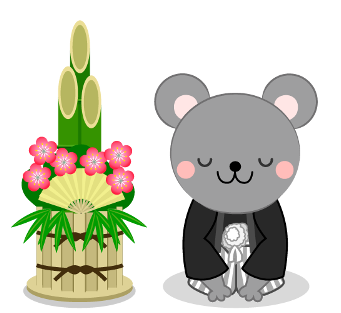
謹賀新年or... a Happy New Year for 2020 to all our customers, past, present and future. Twenty-twenty may be perfect eyesight, but it will also be the Year of the Rat, here represented but a cute, if somewhat over-dressed, mouse saying Yoroshiku!. And the red padlock?
A long-time customer asked me the other day: "What does the red padlock mean? I'm sure there used to be a green one..." Well, actually no, there never was a padlock at all. What has happened is that browsers have started marking any site using the original http:// web protocol with various indications that they are "insecure". This is a bit misleading: it simply means that the connection is not encrypted, so in principle the government might be spying on which puzzles you are looking at. Encryption is essential for anything involving payment details, but we do not collect these directly, since they are handled by PayPal (and of course you should check there is a green padlock, and an https:// connection there). Back in 2002, when Imaginatorium Shop opened its virtual doors, encryption was only for payment sites, but now most sites are switching, and we too will soon be getting a new domain with a green padlock. Please be patient, but look for changes in the new year. |
"A kind of blog..." My sporadic comments, mostly topical, on shop matters. (Brian Chandler)
|

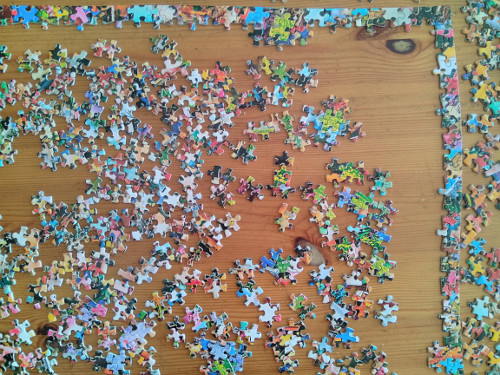 I don't normally look at the box ("cheating"!) and I don't normally start with the edge pieces, as I enjoy watching the picture emerge from chaos. But here it is all but impossible to sort the pieces by basic area - the sky pieces, the grass, the boat, and so on - so I settled on the edge pieces first. This didn't actually take too long, but then the real struggle begins. I would go through the pieces, choosing some distinctive colour, and just try to find any pair of pieces that fitted together. Ever so gradually, bits got joined together; but unlike a normal puzzle, where there are always coherent areas of the same texture, here the pieces just joined in random squiggly clusters.
I don't normally look at the box ("cheating"!) and I don't normally start with the edge pieces, as I enjoy watching the picture emerge from chaos. But here it is all but impossible to sort the pieces by basic area - the sky pieces, the grass, the boat, and so on - so I settled on the edge pieces first. This didn't actually take too long, but then the real struggle begins. I would go through the pieces, choosing some distinctive colour, and just try to find any pair of pieces that fitted together. Ever so gradually, bits got joined together; but unlike a normal puzzle, where there are always coherent areas of the same texture, here the pieces just joined in random squiggly clusters.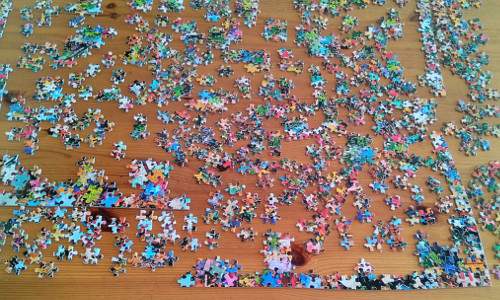 Keep going...
Keep going...
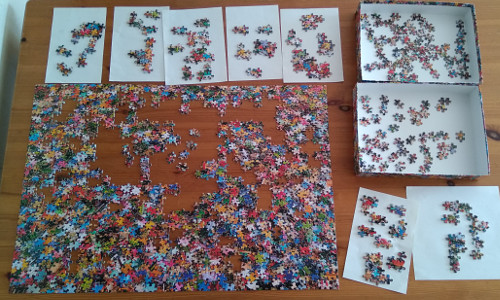 Although I ended up with several large "lumps", connected pieces with no connection to the edges, curiously the corners definitely filled in first. I'll leave the explanation of this to the "spoiler" box below.
Although I ended up with several large "lumps", connected pieces with no connection to the edges, curiously the corners definitely filled in first. I'll leave the explanation of this to the "spoiler" box below.
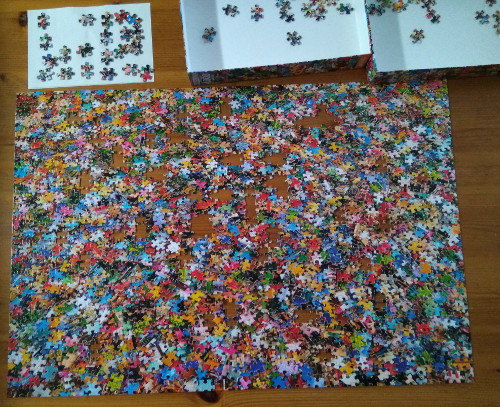 And eventually it was just a question of filling in the holes. (Sorry, I would have put the puzzle on a more contrasting colour if I had thought more carefully about photography!)
And eventually it was just a question of filling in the holes. (Sorry, I would have put the puzzle on a more contrasting colour if I had thought more carefully about photography!)